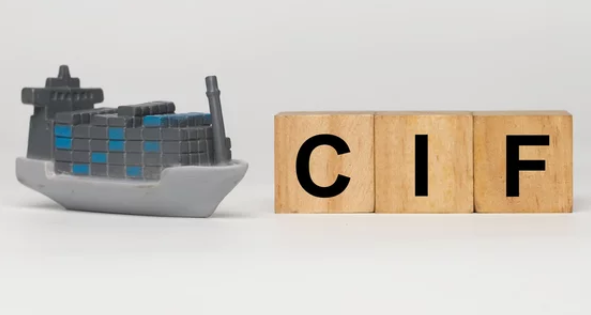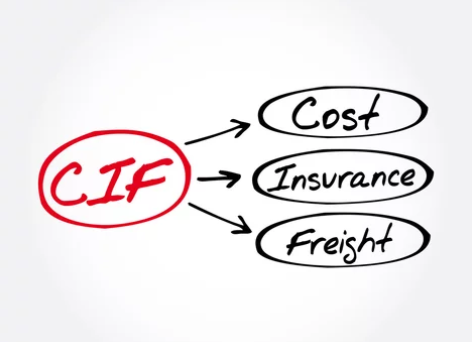
Here’s a detailed breakdown of CIF (Cost, Insurance, and Freight):
1. Seller’s Responsibilities
Under CIF, the seller has several key obligations:
Freight Cost and Transport to the Destination Port: The seller must arrange and pay for the shipment of the goods from the port of origin to the destination port as specified in the contract.
Procurement of Insurance: The seller is obligated to purchase insurance for the goods in transit, covering at least the minimum level of coverage. This insurance protects the buyer, although the buyer may also choose to buy additional coverage if desired.
Customs Clearance for Export: The seller is responsible for handling all export customs documentation and paying any export duties or fees.
Risk Until Goods Are Loaded onto the Vessel: The seller bears the risk of loss or damage until the goods are loaded onto the vessel at the port of shipment. After that point, the risk passes to the buyer.
2. Buyer’s Responsibilities
Once the goods are loaded onto the vessel, the buyer assumes the following responsibilities:
Risk After Loading: After the goods are loaded onto the vessel, the buyer assumes all risks of damage or loss, despite the seller covering the freight costs and insurance to the destination port.
Customs Clearance for Import: The buyer is responsible for import customs clearance, including paying any import duties or taxes when the goods arrive at the destination port.
Arranging Additional Insurance if Needed: The seller’s obligation is to purchase only a minimum insurance coverage. If the buyer desires additional or more comprehensive insurance, they are responsible for arranging and paying for it.
3. Delivery and Transfer of Risk
a. Delivery Completion When Goods Are Loaded onto the Vessel
The delivery is considered complete, and the seller’s responsibility for the goods ends once the goods are loaded onto the vessel at the port of origin. From this point, the buyer assumes all risks related to the goods.
b. Transfer of Risk
The risk of loss or damage transfers from the seller to the buyer as soon as the goods are loaded onto the vessel. This distinction is crucial under CIF, as the seller pays for insurance and freight but is no longer responsible for any risks once the goods are on the vessel.
4. Comparison with Other Incoterms
CIF vs. CFR (Cost and Freight):
Both CIF and CFR require the seller to pay for the transport costs to the destination port, but under CIF, the seller must also purchase insurance. CFR does not require the seller to provide insurance.
CIF vs. FOB (Free On Board):
In FOB, the seller’s responsibility ends once the goods are loaded onto the vessel, and the buyer pays for freight and insurance. In CIF, the seller’s responsibility includes paying for freight and insurance up to the destination port.
CIF vs. EXW (Ex Works):
Under EXW, the buyer handles all shipping arrangements and bears all risks and costs from the seller’s premises onward. In CIF, the seller arranges and pays for transport and insurance to the destination port, while the buyer only takes on risks once the goods are loaded.

5. Advantages of CIF
Convenient for Buyers with Limited Shipping Knowledge: CIF allows buyers to have the goods delivered to the destination port with minimum involvement in the shipping process.
Seller Manages Insurance: Since the seller arranges for insurance, the buyer is protected from a minimum level of risk, which can be advantageous if the buyer lacks experience in international shipping.
Cost Control for Sellers: Sellers can negotiate better freight and insurance rates, which may reduce the overall shipping cost and provide a more competitive offer.
6. Real-World Example of CIF
A tea producer in India sells a shipment of tea to a buyer in the United Kingdom under CIF terms. The tea producer arranges for the tea to be loaded onto a vessel at the port of Mumbai and pays for shipping and insurance to the port of London. The seller also obtains insurance that provides the buyer with minimum coverage in case of loss or damage. However, once the tea is loaded onto the vessel in Mumbai, the risk of loss or damage transfers to the buyer in the UK, even though the seller has arranged for insurance and freight to London.
7. Conclusion
CIF (Cost, Insurance, and Freight) is a beneficial Incoterm for international maritime trade, particularly when the buyer wants to minimize logistics involvement but still ensure a minimum level of insurance. The seller is responsible for arranging transport and insurance to the destination port, which provides a level of risk protection for the buyer. However, buyers must understand that they assume the risk once the goods are loaded onto the vessel and may need to arrange additional insurance for comprehensive coverage.